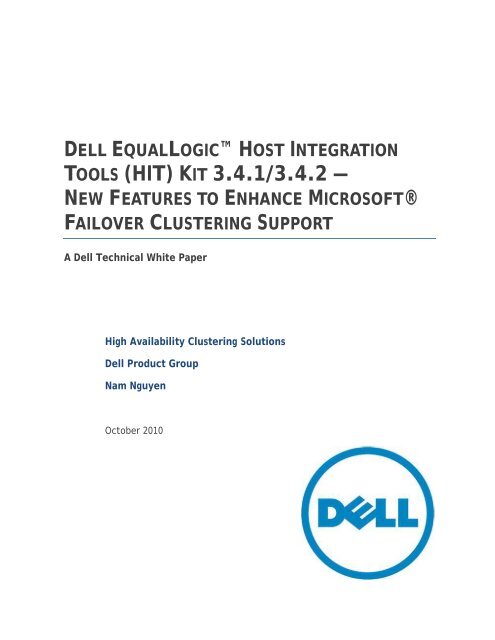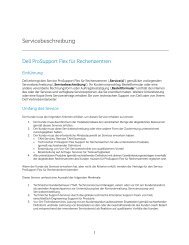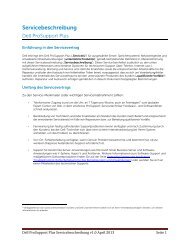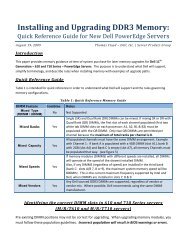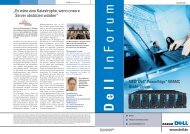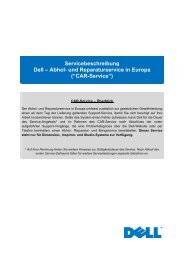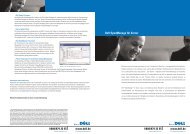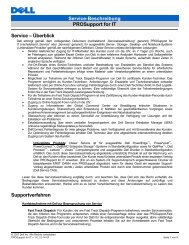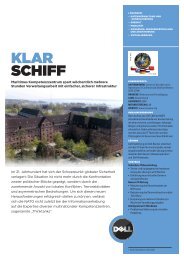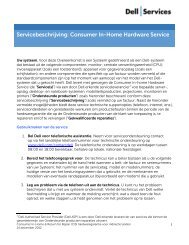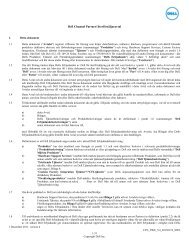TOOLS (HIT) KIT 3.4.1/3.4.2 — - Dell
TOOLS (HIT) KIT 3.4.1/3.4.2 — - Dell
TOOLS (HIT) KIT 3.4.1/3.4.2 — - Dell
You also want an ePaper? Increase the reach of your titles
YUMPU automatically turns print PDFs into web optimized ePapers that Google loves.
DELL EQUALLOGIC HOST INTEGRATION<br />
<strong>TOOLS</strong> (<strong>HIT</strong>) <strong>KIT</strong> <strong>3.4.1</strong>/<strong>3.4.2</strong> <strong>—</strong><br />
NEW FEATURES TO ENHANCE MICROSOFT®<br />
FAILOVER CLUSTERING SUPPORT<br />
A <strong>Dell</strong> Technical White Paper<br />
High Availability Clustering Solutions<br />
<strong>Dell</strong> Product Group<br />
Nam Nguyen<br />
October 2010
EqualLogic <strong>HIT</strong> Kit <strong>3.4.1</strong>/<strong>3.4.2</strong> <strong>—</strong> New Features to Enhance Microsoft Failover Clustering Support<br />
Executive Summary<br />
EqualLogic PS-Series arrays are ideal for use as the shared storage system in the Failover Cluster<br />
configuration. PS-Series arrays provide high availability, scalability and manageability. The EqualLogic<br />
Host Integration Tools (<strong>HIT</strong>) Kit is a comprehensive collection of tools/components to facilitate<br />
deployment and enhance performance of standalone as well as clustered servers. This paper discusses<br />
2 new enhancements being introduced with <strong>HIT</strong> Kit <strong>3.4.1</strong>/<strong>3.4.2</strong> for Microsoft Failover Clustering:<br />
Clustered Shared Volume Support and Dynamic Allocation of iSCSI Connections so that users running<br />
<strong>Dell</strong> Failover Cluster with EqualLogic PS-Series understand better how these features can help them.<br />
THIS W<strong>HIT</strong>E PAPER IS FOR INFORMATIONAL PURPOSES ONLY, AND MAY CONTAIN TYPOGRAPHICAL<br />
ERRORS AND TECHNICAL INACCURACIES. THE CONTENT IS PROVIDED AS IS, WITHOUT EXPRESS OR<br />
IMPLIED WARRANTIES OF ANY KIND.<br />
© 2010 <strong>Dell</strong> Inc. All rights reserved. Reproduction of this material in any manner whatsoever without<br />
the express written permission of <strong>Dell</strong> Inc. is strictly forbidden. For more information, contact <strong>Dell</strong>.<br />
<strong>Dell</strong>, the DELL logo, the DELL badge, and EqualLogic are trademarks of <strong>Dell</strong> Inc. Microsoft, Windows,<br />
Windows Server, SQL Server, and Hyper-V are either trademarks or registered trademarks of Microsoft<br />
Corporation in the United States and/or other countries. Other trademarks and trade names may be<br />
used in this document to refer to either the entities claiming the marks and names or their products.<br />
<strong>Dell</strong> Inc. disclaims any proprietary interest in trademarks and trade names other than its own.<br />
October 2010<br />
Page ii
EqualLogic <strong>HIT</strong> Kit <strong>3.4.1</strong>/<strong>3.4.2</strong> <strong>—</strong> New Features to Enhance Microsoft Failover Clustering Support<br />
Contents<br />
Executive Summary ....................................................................................................... ii<br />
Introduction ................................................................................................................ 2<br />
EqualLogic Host Integration Tools (<strong>HIT</strong>) Kit........................................................................... 2<br />
New Features in <strong>HIT</strong> Kit <strong>3.4.1</strong>/<strong>3.4.2</strong> ................................................................................... 3<br />
Clustered Shared Volume (CSV) Support .............................................................................. 4<br />
Dynamic Allocation of iSCSI Connections .............................................................................. 4<br />
Information on <strong>Dell</strong> Failover Cluster Solutions ....................................................................... 5<br />
Page 1
EqualLogic <strong>HIT</strong> Kit <strong>3.4.1</strong>/<strong>3.4.2</strong> <strong>—</strong> New Features to Enhance Microsoft Failover Clustering Support<br />
Introduction<br />
A failover cluster is a group of systems that collaborates to run a common set of applications, but<br />
presents itself as a single logical system to client applications. The systems (or nodes) in the cluster are<br />
physically connected either by a local area network (LAN) or a wide area network (WAN), and are<br />
configured with Microsoft® Windows Server® 2008 R2 Failover Clustering software.<br />
Failover clusters are well suited to mission-critical applications that require high availability and<br />
scalability, such as order processing and tracking, inventory control, e-commerce, databases,<br />
messaging systems, file and print services, and virtualized workloads. They help reduce downtime<br />
associated with planned and unplanned events by removing any single point of failure within the<br />
configuration that can cause clustered applications or services to become unavailable. If a hardware or<br />
software component failure causes a service failure, the cluster automatically restarts the failed<br />
service on a functional cluster node, ensuring that no data is lost and that there is minimal disruption<br />
to end users. Once the problem is corrected, services can be automatically balanced by cluster<br />
software or manually balanced by the administrator across all functional nodes.<br />
<strong>Dell</strong> EqualLogic PS-Series arrays are ideal to use as the shared storage system in a failover cluster<br />
configuration, because they provide high availability, scalability, and manageability.<br />
• High Availability Features: Hot-swappable fans and power supplies, redundant storage<br />
controllers, RAID, hot-spare disk, redundant paths to the storage system, online storage<br />
firmware update, snapshot and replication capabilities<br />
• Scalability Features: Tie-storage system, peer architecture, on-demand volume expansion, and<br />
auto-rebalancing<br />
• Manageability: Easy to install and use, thin provisioning, virtualization support, self-managed,<br />
and comprehensive monitoring and deployment tools<br />
EqualLogic Host Integration Tools (<strong>HIT</strong>) Kit<br />
The EqualLogic <strong>HIT</strong> Kit includes:<br />
• Remote Setup Wizard (RSW) <strong>—</strong> Quickly and easily initialize PS Series storage arrays, set up and<br />
configure access to a PS Series group, and configure multipath I/O on Windows Server 2003,<br />
Windows Server 2008, and Windows Server 2008 R2 operating systems.<br />
• Multipath I/O Device Specific Module (DSM) <strong>—</strong> Configure multiple redundant network paths<br />
between a system running the Windows® operating system and PS Series group volumes for<br />
high availability and high performance.<br />
• EqualLogic Host Connection Manager (EHCM) – A user mode service that periodically retrieves<br />
the current table from the PS Series Group, monitors iSCSI sessions and SAN topology, and<br />
reconfigures iSCSI session mesh when necessary.<br />
• Auto-Snapshot Manager/Microsoft Edition (ASM/ME) <strong>—</strong> A Microsoft Volume Shadow Copy (or<br />
Snapshot) Service (VSS) requestor that makes application-consistent smart copies of volumes.<br />
Creates snapshots, clones, and replicas to provide point-in-time protection of critical data for<br />
supported applications, including Microsoft SQL Server®, Exchange Server, Hyper-V, and NTFS<br />
file shares.<br />
Page 2
EqualLogic <strong>HIT</strong> Kit <strong>3.4.1</strong>/<strong>3.4.2</strong> <strong>—</strong> New Features to Enhance Microsoft Failover Clustering Support<br />
• VSS Provider <strong>—</strong> Use VSS to create and manage volume snapshots and replicas in a PS Series<br />
group.<br />
• VDS Provider <strong>—</strong> Use the Microsoft Virtual Disk Service (VDS) and Microsoft Storage Manager for<br />
SANs to create and manage volumes in a PS Series group.<br />
• Microsoft iSCSI Software Initiator <strong>—</strong> Include the iSCSI port driver, Initiator Service, and<br />
Software Initiator to help connect to iSCSI devices via the Windows TCP/IP stack using NICs.<br />
• Java Runtime Environment Update <strong>—</strong> Install necessary Java Runtime Environment (JRE)<br />
updates for the Group Manager graphical user interface (GUI).<br />
New Features in <strong>HIT</strong> Kit <strong>3.4.1</strong>/<strong>3.4.2</strong><br />
<strong>HIT</strong> Kit version <strong>3.4.1</strong>/<strong>3.4.2</strong> includes the following enhancements and changes:<br />
• Microsoft Exchange Enhancements<br />
o Support for Exchange Server 2010 and 2010 SP1 (<strong>HIT</strong> <strong>3.4.2</strong>)<br />
o LCR and SCR support for Exchange Server 2007<br />
o Support Restore as New for Exchange<br />
• Support for SQL Server 2008 R2 (<strong>HIT</strong> <strong>3.4.2</strong>)<br />
• New PS Series firmware version 5.0 support<br />
o Support for thin clones and template volumes<br />
o SAN data copy offload features<br />
• Support for HPC iSCSI provider<br />
• Remote setup for command-line interface (CLI)<br />
• iSCSI provider for Windows HPC Server<br />
• Offline smart copies<br />
• Support for cloning replicas<br />
• Bulk operations support<br />
• Improvements for Multi-Path I/O (MPIO)<br />
• ASMCLI enhancements<br />
• Simplified trace logging<br />
• Enhancements in Microsoft failover clustering<br />
o Clustered shared volume (CSV) support<br />
o Dynamic allocation of iSCSI connections<br />
These new features and enhancements are well documented in the Host Integration Tools for Microsoft<br />
Windows version <strong>3.4.1</strong>/<strong>3.4.2</strong> Release Notes. This paper focuses on two specific enhancements in<br />
Microsoft failover clustering: CSV support and dynamic allocation of iSCSI connections.<br />
Page 3
EqualLogic <strong>HIT</strong> Kit <strong>3.4.1</strong>/<strong>3.4.2</strong> <strong>—</strong> New Features to Enhance Microsoft Failover Clustering Support<br />
Clustered Shared Volume (CSV) Support<br />
CSV is a new failover clustering feature in Windows Server 2008 R2 that allows concurrent access to a<br />
shared disk by multiple cluster nodes. When used with Hyper-V, CSV provides the following benefits:<br />
• Implements transparency regarding which node owns each volume.<br />
• Uses disk space required for Virtual Machines (VMs) more efficiently by placing multiple Virtual<br />
Hard Disks (VHDs) on a single CSV volume.<br />
• Reduces the time and chance of disconnection for VMs during Live Migration, since the cluster<br />
disk does not have to be taken offline on one node and brought online on another.<br />
• Provides consistent and single namespace.<br />
• Makes the VM the smallest unit for failover, so that the physical disk and all cluster resources<br />
in a group do not failover together<br />
The Auto-Snapshot Manager supports the following operations for CSV environments:<br />
• Smart copy and smart copy schedule creation for any VM on a CSV<br />
• Selective restore of VMs on CSVs<br />
• Moving the coordination node to the local/current node<br />
The following constraints apply to Auto-Snapshot Manager support for CSVs:<br />
• In a CSV-enabled failover cluster, you cannot create a Smart Copy (or a Smart Copy Schedule)<br />
for a CSV from any node, including the coordination node.<br />
• You cannot add a CSV or any VMs that reside on a CSV to a collection.<br />
• ASM/ME does not permit in-place restores of CSVs, because every copy of a CSV is a torn smart<br />
copy.<br />
Dynamic Allocation of iSCSI Connections<br />
EHCM monitors and manages iSCSI sessions on an EqualLogic volume, ensuring that there are paths<br />
available to each member hosting the volume so that I/O can send directly to that member.<br />
In previous <strong>HIT</strong> Kit releases, EHCM established two connections to each PS Series array member hosting<br />
the volume by default, up to a maximum of six connections. This approach ensured maximum<br />
availability and performance, but was inefficient in the Microsoft Failover Clustering environment.<br />
Because the non-CSV volume only accessed one cluster node any point in time, only the active node<br />
that owned the volume made use of iSCSI sessions; the connections from other passive node(s)<br />
remained idle but consumed resources on the PS Series group.<br />
Page 4
EqualLogic <strong>HIT</strong> Kit <strong>3.4.1</strong>/<strong>3.4.2</strong> <strong>—</strong> New Features to Enhance Microsoft Failover Clustering Support<br />
To reduce the overhead of idling connections from passive nodes while still maintaining desired<br />
performance and availability, EHCM in <strong>HIT</strong> Kit <strong>3.4.1</strong>/<strong>3.4.2</strong> adds an intelligent algorithm to dynamically<br />
allocate iSCSI connections as follows:<br />
• If the volume is a CSV volume that can be simultaneously accessed from different cluster<br />
nodes, EHCM establishes two connections per PS Series array member.<br />
• If the volume is not a CSV volume:<br />
o If the node owns the volume, then EHCM establishes two connections per PS Series<br />
array member, up to six connections for that volume.<br />
o If the node does not own the volume, then EHCM only establishes two connections,<br />
regardless of the number of array members in the group. If the volume resides on<br />
multiple PS Series array members, one or two array members may not have an iSCSI<br />
connection.<br />
• EHCM actively monitors the state of the volume. If the state changes, the number of<br />
connections adjusts accordingly. For example, if a volume with three members moves from<br />
node A to node B, then EHCM will reduce the number of connections on node A from six to two,<br />
and increase the number of connections on node B from two to six.<br />
Users will no longer see behavior in which each volume has the same number of connections from each<br />
cluster node. The number of connections on the volume depends on how the volume is used in the<br />
cluster node, and can vary among the nodes. This new feature works with all PS-Series arrays supported<br />
in the <strong>Dell</strong> Failover Cluster and helps maintain the desirable performance/availability while reducing the<br />
excess iSCSI connections.<br />
Information on <strong>Dell</strong> Failover Cluster Solutions<br />
For more information on <strong>Dell</strong> Failover Cluster Solutions, see:<br />
Cluster documentation:<br />
http://docs.us.dell.com/support/edocs/systems/clusters/<br />
Cluster Configuration Support Matrices:<br />
http://www.dell.com/content/topics/global.aspx/sitelets/solutions/cluster_grid/clustering_ha?c=us&cs=555<br />
&l=en&s=biz&~page=3&~tab=4<br />
Page 5


